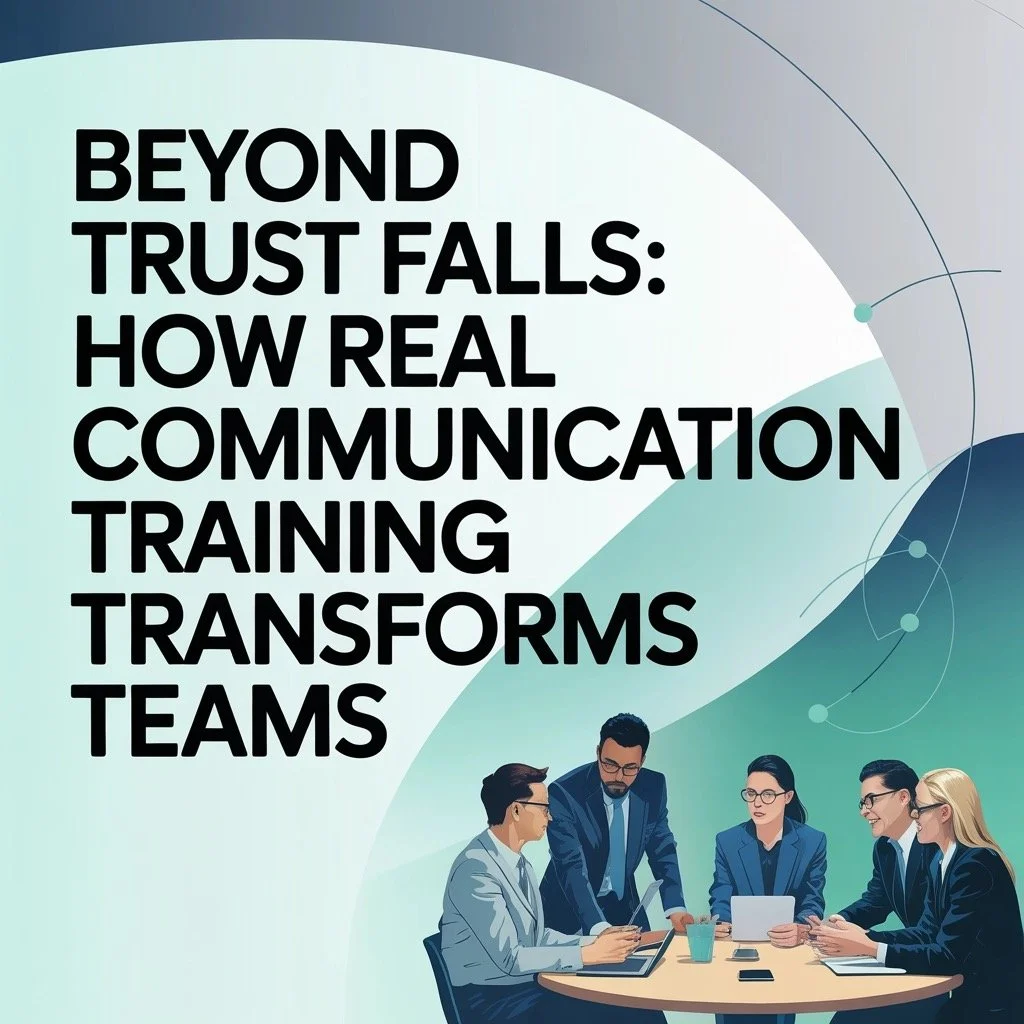Beyond Trust Falls: How Real Communication Training Transforms Teams
Remember trust falls? You know, those team-building exercises where you close your eyes, cross your arms over your chest, and fall backward, trusting your colleagues will catch you before you hit the floor. While they might create a few memorable (and occasionally awkward) moments, these one-off activities rarely translate into lasting workplace transformation.
Why Traditional Team Building Falls Short
We've all been there—the mandatory "fun" day where teams engage in contrived activities before returning to the same old communication patterns on Monday morning. The problem isn't that these activities are inherently bad; it's that they're disconnected from real workplace challenges.
Traditional team building often:
Creates temporary enthusiasm that quickly fades
Fails to address underlying communication issues
Doesn't provide practical tools for everyday interactions
Feels forced rather than authentic
Lacks meaningful follow-through
One HR director I spoke with put it perfectly: "We spent thousands on a weekend retreat with rope courses and blindfolded obstacle challenges. Everyone had fun, but six weeks later, our teams were still miscommunicating about project deadlines and talking over each other in meetings."
This disconnect happens because genuine team transformation doesn't come from artificial scenarios—it emerges from learning real communication skills that apply directly to workplace challenges.
The Science Behind Effective Team Communication
What makes teams truly excel isn't how well they can catch each other during trust falls—it's how effectively they communicate day in and day out.
Research consistently shows that communication quality directly impacts team performance. A landmark Google study called "Project Aristotle" analyzed data from 180+ teams and discovered that psychological safety—the ability to take risks and be vulnerable with teammates—was the single most important factor in high-performing teams.
The highest-performing teams weren't necessarily composed of the most skilled individuals. Rather, they excelled because members:
Spoke roughly the same amount during meetings (equal conversation participation)
Demonstrated high "social sensitivity" (ability to read emotional cues)
Created environments where people felt safe expressing ideas
Established clear communication norms
These findings reveal something crucial: effective teams aren't built through occasional bonding activities but through consistently practiced communication skills and carefully cultivated environments.
Real Communication Training: What Actually Works
1. Addressing Verbal Barriers Head-On
Effective communication training starts by identifying and dismantling common verbal barriers that plague teams:
Jargon and technical language: While industry terminology has its place, excessive jargon can exclude team members and create artificial divisions. Real training helps teams recognize when specialized language helps or hinders understanding.
Defensive communication: Many teams develop patterns of blame, criticism, and defensiveness. Training that addresses these patterns head-on helps team members recognize their triggers and shift toward more productive responses.
Idea screening: Some workplace cultures unconsciously filter ideas based on who presents them rather than their merit. Proper training establishes protocols that ensure all voices receive equal consideration.
A pharmaceutical research team I worked with implemented a simple "jargon jar"—anyone using unexplained technical terms contributed a dollar. Not only did it create awareness, but it also funded their monthly coffee meetups!
2. Active Listening as a Core Skill
While most people believe they're good listeners, research suggests otherwise. One study found that the average person remembers just 25% of what they hear. Real communication training transforms listening from passive hearing to active engagement through:
Inquiring techniques: Training participants to ask clarifying questions before responding
Reflection practices: Repeating back key points to confirm understanding
Attention management: Developing the ability to focus fully on speakers without mental distractions
These skills might seem basic, but they're rarely practiced consistently in workplace settings where interruptions, multitasking, and quick responses are the norm.
3. Creating Psychological Safety Through Structure
Meaningful team building creates environments where people feel safe taking interpersonal risks. Unlike trust falls, effective communication training builds psychological safety through:
Structured feedback protocols: Teaching teams how to deliver criticism constructively
Facilitated vulnerability: Creating appropriate opportunities for team members to share challenges
Conflict navigation frameworks: Providing clear steps for addressing disagreements productively
A tech startup implemented a "concerns first" protocol in all project meetings—team members share potential obstacles before discussing solutions. This simple structure transformed their communication culture by normalizing constructive criticism.
4. Work-Relevant Practice (Not Random Activities)
The most effective training connects directly to real workplace scenarios. Instead of generic exercises, transformative communication training might include:
Scenario-based simulations: Role-playing difficult client conversations or team disagreements
Real-time project debriefs: Analyzing communication successes and failures in recent work
Communication audits: Examining actual team emails, meetings, and documentation to identify patterns
One manufacturing team recorded their weekly planning meetings (with permission) and analyzed speaking patterns. They discovered that junior team members spoke an average of just 3 minutes in hour-long meetings, while managers dominated the conversation.
5. Consistency Over Flash
Lasting transformation requires consistent practice, not flashy one-time events. Effective communication training embeds ongoing habits through:
Micro-practices: Brief, daily communication exercises teams can incorporate into existing routines
Regular reflection: Scheduled check-ins specifically focused on communication effectiveness
Progressive skill building: Training that builds complexity as teams master foundational skills
Real-World Transformation: What's Possible
When teams move beyond trust falls to genuine communication training, the results can be remarkable:
Case Study: Financial Services Team
A team of financial analysts struggled with project handoffs—critical information was frequently lost between team members, creating costly errors. Traditional team building hadn't helped. After implementing structured communication training focused on documentation protocols and handoff conversations, error rates decreased by 62% within three months.
The key wasn't getting team members to like each other more (they already did). It was giving them practical tools to communicate effectively about their work.
Case Study: Healthcare Leadership
A hospital management team faced chronic tension between clinical and administrative staff. After implementing comprehensive communication training that addressed perspective-taking and discipline-specific language, interdepartmental projects were completed 40% faster, and employee satisfaction scores increased significantly.
How to Move Beyond Trust Falls in Your Organization
Ready to transform your team's communication? Here are practical steps to get started:
Assess current patterns: Before implementing training, gather data on existing communication challenges through surveys, interviews, or communication audits.
Connect training to work: Ensure all communication exercises directly relate to actual workplace scenarios your team faces.
Build progressive skills: Start with foundational skills like active listening before moving to more complex areas like conflict resolution.
Create practice structures: Establish regular opportunities for teams to practice new communication skills in low-stakes environments.
Measure impact: Track specific communication metrics before and after training to demonstrate value.
Embed ongoing habits: Implement regular communication practices that continue long after formal training ends.
The Bottom Line: Communication That Transforms
Effective teams aren't built through occasional bonding activities—they're developed through intentional, consistent communication practices that address real workplace challenges.
When organizations move beyond superficial team building to meaningful communication training, they don't just create momentary connections. They build teams capable of navigating complex challenges, leveraging diverse perspectives, and consistently delivering exceptional results.
Trust falls might create a few memorable moments, but real communication training creates lasting transformation.
At Chatterbox Workshops, we design communication training programs that go beyond typical team-building activities to create lasting workplace transformation. Learn more about our approach or contact us to discuss your team's specific communication challenges.



